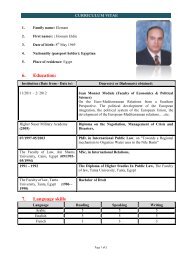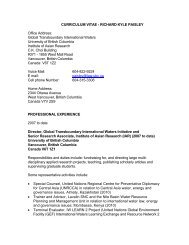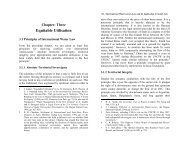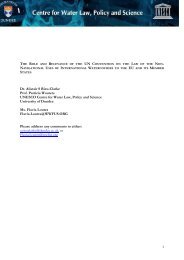Upreti, Trilochan, International Watercourses Law and Its Application ...
Upreti, Trilochan, International Watercourses Law and Its Application ...
Upreti, Trilochan, International Watercourses Law and Its Application ...
Create successful ePaper yourself
Turn your PDF publications into a flip-book with our unique Google optimized e-Paper software.
190 / <strong>International</strong> <strong>Watercourses</strong> <strong>Law</strong> <strong>and</strong> <strong>Its</strong> <strong>Application</strong> in South Asia Prospects <strong>and</strong> Problems of Nepalese Water Resources / 191given for 199 years, during which sovereign rights <strong>and</strong>territorial jurisdiction would be retained by Nepal. 33From the legal viewpoint, significant changes were made in theagreement, such as the right to divert water from the tributaries,Nepal’s involvement in the project implementation, <strong>and</strong>, lessbeneficially, the lease for l<strong>and</strong> prescribed for 199 years. Despitethis, even after the revised agreement <strong>and</strong> its execution, theoriginal intention to bring these benefits to Nepal has not fullymaterialised. The Chatra Inundation Canal which was proposedto irrigate 66,000 ha of l<strong>and</strong> in Nepal, has in the event only ledto the irrigation of 10,000 ha. Moreover, it was felt thatirrigation <strong>and</strong> flood control benefits to Nepal from the projectwould have been greater had the barrage site been locatedfurther upstream at Barahkesthra, as initially designed, butwhich was later changed to the Indo-Nepal border point. 34 Ithas been argued that in order to take maximum benefits fromNepal’s water resources, India had applied pressure <strong>and</strong> usedbargaining tactics, constantly pushing Nepal to agree on theKosi project for the period of 199 years, in exchange for a trade<strong>and</strong> transit treaty renewable every 5 years (somethingunprecedented in world history), whereas the life of a waterresources project is normally considered to be 50 years. 35The G<strong>and</strong>ak Project Agreement (1959) is the third agreementthat was constructed to bring India benefits, i.e. flood control,irrigation <strong>and</strong> hydropower. On the G<strong>and</strong>ak, a barrage wasconstructed on a reach of the river, which forms the boundarybetween India <strong>and</strong> Nepal. The project was to provide irrigationto a gross comm<strong>and</strong> area of 1,340,000 ha in Bihar, 500,000 hain Uttar Pradesh (both Indian States), <strong>and</strong> 63,000 ha in Nepal.33 II YBILC 1974, p.p. 102-103. In the revised agreements Clause 1, 2, 3,4 (I & II), 5, 10 & 15 were amended.34 B. G. Verghese, R. R. Iyer, P.K. Ahamad, B. B. Pradhan & S.K. Malla(eds), Converting Water Into Wealth: Regional Co-operation inHarnessing the Eastern Himalayan Rivers, New-Delhi: Konark Pub.,1994, pp. 31-33.35 Supra note 8, p. 259.Utilising the head available on the main western canal, ahydropower plant of 15 MW was also provided for in theproject as a secondary benefit. 36 The fate of this agreement wasalso similar to that of the Kosi agreement: it was heavilycriticised by Nepali politicians. Subsequently both partiesagreed to revise this agreement; after its revision, some morebenefits were given to Nepal. Nonetheless, in relation to thecriticism, it has also been argued that in those projects India hasinvested a huge amount of money, manpower <strong>and</strong> technology,<strong>and</strong> that it is therefore natural that she should accrue morebenefits than Nepal. 37 To some extent, the argument is valid;however, Nepal’s interests cannot be ignored entirely.The road bridge constructed under this project, for which Nepalwas assured of a locking arrangement for facility of riverinetraffic across the barrage free of any tolls, has proved to be aprovision that has so far remained mere theory, as no inl<strong>and</strong>water navigation was developed. The other fundamentalrecognitions of Nepal’s rights which were accorded enabled herto make upstream withdrawals. In the view of many Nepalese,Nepal was again cheated <strong>and</strong> exploited. Sharma, a prominentgeologist, maintained that:"…had Nepal been economically strong, it wouldhave constructed the entire system <strong>and</strong> sold thebenefit at a fair price to India by utilising herterrain as a resources site…". 38Nepal’s concern <strong>and</strong> objections are underst<strong>and</strong>able, as thepromises made in these treaties were never fulfilled by India;for example the Chatara canal under the Kosi agreement, whichremains defunct <strong>and</strong> which Nepal had to renovate with an IDAloan after she took over its operation in 1976, <strong>and</strong> thenavigation facility as stipulated in the G<strong>and</strong>ak agreement,which was never undertaken. Similarly, the hydro generation36 Supra note 17, pp. 102-108.37 Ibid. p. 107.38 Supra note 21, p. 280.












